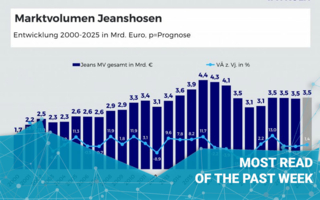20/04/2021 – Setlog — auf Deutsch lesen
Marc O’Polo: Casual and powerful into the future
“At the beginning of the corona crisis, it was particularly useful that we had Osca as a software.” Dr. Patric Spethmann, COO Marc O’Polo. By Thilo Jörgl
The Marc O’Polo fashion brand is committed to sustainability and with the push of COO Dr. Patric Spethmann, is also driving digitization forward. The company relies on new technologies such as SAP S/4HANA and the About You Cloud, as well as proven tools such as Setlog’s SCM software Osca.
Marc O’Polo. Many who grew up in Germany in the 80s, associate this brand with fashionable, casual sweatshirts. Those who were born earlier think of hand-woven cotton shirts from India when they hear the modified name of the Venetian explorer. The company, founded in Sweden in 1967, was already offering such shirts in the 1970s. While the competition offered shirts made of non-iron and crease-resistant polyester, Marc O’Polo was focusing on natural materials. The company never wanted to be rebellious or overly fashionable. Instead, it went against the mainstream and focused on high-quality, timeless yet modern products. Customers were happy to pay a little more money for this type of fashion. Sustainable and classy – that’s a strategy that works. Yesterday, as well as today.
The fashion brand was founded in Stockholm in 1967 by the Swedes Rolf Lind and Göte Huss along with the American Jerry O'Sheets. The German subsidiary was founded a year later by Werner Böck, based in Stephanskirchen (Rosenheim district). Ten years after the company was founded, Böck took over the company. This resulted in the founding of Marc O’Polo International, and the company headquarters was moved from Stockholm to Stephanskirchen.
Werner Böck, who is now a member of the supervisory board, was consistent not only in his brand positioning, but also in not copying the ploy of the mainstream. Going his own way and acting with foresight proved successful for him. In the business year 2005, the company made 158 million euros in sales; by 2019, it was already up to 472 million euros. Böck, as well as Dieter Holzer, CEO since 2017, and co-CEO Maximilian Böck, not only act in an anticipatory manner when it comes to brand strategy – but also in other areas such as sales, supply chain management and digitization.
Looking back:
When other fashion companies were still dismissing the “platform hype”, Marc O’Polo jumped at the chance to use Internet platforms as an additional sales channel. The company saw the multichannel approach not as a difficult strategy to manage, but as an opportunity to gain access to different customer groups. In 2016, it was named “Best Multichannel Retailer”. The fashion company distinguished itself early on by being particularly active on platforms. This was not only because of sales, but also to increase brand awareness. Equally important, the management considered that data generated on platforms could be used to make well-founded decisions on assortment selection for other wholesale channels.
The management recognized early on that good data and IT skills are fundamentally important for a successful multichannel process. The credo: Only based on excellent data can a click and collect service be offered, as an example. After all, if customers order clothing on the Internet and want to try it on or pick it up at the nearest store, the inventories of all stores must be recorded centrally.
Excellent data is also the be-all and end-all in purchasing and supply chain management. But it is not much use if it’s lying dormant in Excel files, or must be sent back and forth between supply chain partners via e-mail. That's why, back in 2015, Marc O’Polo decided to introduce the SCM software Osca from the Bochum-based provider Setlog for their inbound supply chain. The motto at the time was: Media discontinuities must be a thing of the past; the value chain must become transparent. The Marc O’Polo supply chain is long and includes many partners. The more than 100 suppliers are not only located in Eastern Europe, Portugal and Turkey, but also in China and other Asian countries. For transport, several forwarders are nominated for the various carriers and relations according to the principle of the best price/performance ratio.
With Osca, the company manages a whole range of tasks at once – among others:
pre-production
capacity planning
delivery planning including communication
the carton packing list including label generation
the supplier booking process with the freight forwarder
the transport process and shipment tracking
delivery planning at the central warehouse including the consolidation of the subsequent deliveries
document management and distribution to the suppliers (general Instructions module)
various imports (material, article, article color, order item)
the Debit Note module (messages and claims processing after goods receipt and quality control can be transmitted from Osca to the suppliers)
The Debit Note module is a special feature. “At the time, it was developed especially for Marc O’Polo,” reports Setlog board member Ralf Duester. For example, if not enough parts were delivered, if they arrived too late, or if they have to be processed, the fashion label can send a message to the respective supplier directly from Osca. The message is directly related to the respective article, because a link to the article and order number is established. “In the module, it is possible to exchange messages and have customs-relevant items checked by displaying them on the dashboard,” Duester explains. Osca was also one of the reasons why Marc O’Polo was able to react faster and easier to lockdowns and, as a result, burst delivery deadlines more than other companies during the Corona crisis.
At the start of the first lockdown in Germany, Dr. Patric Spethmann had been with the company for just nine months.
“To set the course for the future,” the supervisory board created the new Logistics and IT division, according to a press release – and appointed Spethmann, who had years of experience as COO at Gries Deco, Tchibo and the Otto Group. “At the beginning of the Corona crisis, we had to make new decisions every day and, for example, change the mode of transport because ports were suddenly closed,” reports Spethmann. “That’s when it was very useful to have Osca as a software and we therefore reacted quickly and specifically to changes in the supply chain.” The COO reports that due to resiliency and flexibility, there were “no major problems” in supply chain management. However, he notes that warehouse capacity was an issue caused by the necessity to close brick-and-mortar stores leaving the distribution center overflowing.
In day-to-day business, Spethmann can rely on a competent team. After all, the following applies to the consumer goods industry: Margins can be optimized above all in procurement and supply chain management. Since prices cannot simply be increased on the market, companies are facing tough global competition, but they are also in corner price situations that more or less force them to keep prices for customers at a constant level.
Especially in the fashion industry, companies are confronted with a multitude of challenges at the same time. These include:
the change from push to pull markets
the increasing complexity in procurement and sales
the internationalization of the brand and the associated logistics
the growing importance of dynamic developments
the acceleration of the company as well as the entire order process
the need for complete solutions and additional services
Successful SCM specialists and buyers base decisions on a three-pillar model to properly position companies for the future.
Optimizing company processes – these include: focusing on core processes, optimizing logistics for omnichannel distribution, optimizing processes and eliminating sub-processes, and creating transparency throughout the chain.
The establishment of a collaborative supply chain: Instead of a chain, a cross-company network is established in which all partners are integrated – from suppliers, agencies, testing laboratories and quality assurance to logistics providers and customers from wholesale to the company's own premises. The reason: A network is more stable than a chain in the event of a disruption.
Building a powerful IT landscape: Numerous systems support modern companies – for example in the areas of online store, SCM, PLM, data warehouse, customs, payment system, production planning and ERP.
Instead of trying to simplify the complexity of the fashion business, Spethmann’s motto is: “Let’s master complexity and create the right solutions for this!” In practice, this means addressing the complexity of the omnichannel strategy and finding an optimal ERP solution for it, looking for an ideal delivery strategy for the retail areas, improving returns management, and setting up intralogistics flexibly – to name just a few examples.
Even in his short time at Marc O’Polo, Spethmann has initiated a number of topics – such as the planning of a long-term, integrated logistics strategy. He has already caused a stir externally with the introduction of an SAP S/4HANA project. Internally, a well-functioning ERP system is enormously important to him. It is the digital heart of a company and must supply all other solutions with data – in real time, when possible. At the same time, data is sent back to the ERP and processed. Only with an optimal ERP solution can the right decisions be made in the shortest possible time.
Marc O’Polo stands for upscale, contemporary Premium Modern Casual Wear. The preference for natural materials, high-quality fabrics and special details characterize the individual style of the premium brand with Scandinavian roots – in line with the philosophy of its founders: The freedom to remain true to oneself. With this claim, Marc O’Polo has become one of the leading international brands in its segment.
Setlog Holding is a provider of customized supply chain management (SCM) solutions. Its core product is the cloud-based SCM software Osca, which is used by over 150 brands in the apparel, electronics, food, consumer goods and hardware sectors. Setlog GmbH is a wholly owned subsidiary of Setlog Holding AG. The company was founded in 2001 and is today one of the leading providers of SCM software with over 35,000 users in 92 countries. The software company employs 60 people at its locations in Bochum (headquarters), Cologne and New York.





